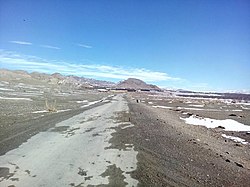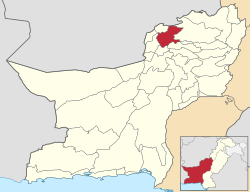Pishin District
This article has multiple issues. Please help improve it or discuss these issues on the talk page. (Learn how and when to remove these template messages)
|
Pishin District
ضلع پشین پښين ولسوالۍ پشین دمگ | |
|---|---|
 View of Bala Niganda Village | |
 Map of Balochistan with Pishin District highlighted | |
| Country | |
| Province | |
| Division | Quetta |
| Headquarters | Pishin |
| Government | |
| • Type | District Administration |
| • Deputy Commissioner | Dr. Yasir Khan Bazai |
| • District Police Officer | N/A |
| • District Health Officer | N/A |
| Area | |
| • Total | 6,218 km2 (2,401 sq mi) |
| Elevation | 1,555 m (5,102 ft) |
| Population (2017) | |
| • Total | 736,903 |
| • Density | 120/km2 (310/sq mi) |
| Time zone | UTC+5 (PST) |
| Calling code | 826[1] |
| National Assembly Seats (2018) | Total (1)
|
| Balochistan Assembly Seats (2018) | Total (3)
|
| Number of Tehsils | 2 |
| Website | quetta |
Pishin (Pashto: پښين, Urdu: ضلع پشین), IPA: pʂin/pçin, is a district in the Balochistan province of Pakistan. District Pishin is located at a strategic point and is 45km² from the provincial headquarters. In 1975, it was bifurcated from Quetta District, while in 1993 part of it was split off to form the new district of Killa Abdullah.[2] Again in 2022, part of it created the new district of Karezat. The name Pishin is a modernized form of ‘Pushang’, which is how the city was designated in (mainly pre-modern) Persian sources (Arabic sources using 'Fushang'). Myth attributes the origin of the Persian designation to a son of the mythical Emperor Afrasiab. Fushing was the spelling used in the records of the Afghan government. The population of Pishin District was 300,000 in 2005.[3]
Administration
[edit]- Pishin Tehsil
- Huramzai Tehsil
- Karezat Tehsil
- Saranan Tehsil
- Barshore Tehsil
- Nana Sahib
Demographics
[edit]| Year | Pop. | ±% p.a. |
|---|---|---|
| 1961 | 58,957 | — |
| 1972 | 131,923 | +7.60% |
| 1981 | 202,256 | +4.86% |
| 1998 | 367,183 | +3.57% |
| 2017 | 736,903 | +3.73% |
| 2023 | 835,482 | +2.11% |
| Sources:[4] | ||
As of the 2023 census, Pishin district has 147,185 households and a population of 835,482. The district has a sex ratio of 104.34 males to 100 females and a literacy rate of 51.07%: 65.85% for males and 36.05% for females.[5][6] 318,031 (38.07% of the surveyed population) are under 10 years of age.[7] 243,785 (29.18%) live in urban areas.[5] 2,441 (0.29% of the surveyed population) are religious minorities, mainly Christians.[8] Pashto is the predominant language, spoken by 99.07% of the population.[9]
Pishin's main ethnic groups are Pashtuns who belong to the Tareen, Syed, Kakar, and Achakzai tribes. However, the Tareen tribe is known to be the ruling one among them.
| Religious group |
1941[10]: 13–14 | 2017[11][12] | ||
|---|---|---|---|---|
| Pop. | % | Pop. | % | |
| Islam |
1,245 | 65.87% | 35,067 | 98.65% |
| Hinduism |
447 | 23.65% | 3 | 0.01% |
| Sikhism |
183 | 9.68% | — | — |
| Christianity |
15 | 0.79% | 473 | 1.33% |
| Ahmadiyya |
— | — | 4 | 0.01% |
| Total population | 1,890 | 100% | 35,547 | 100% |
| Religious group |
1901[13] | 1911[14] | 1921[15] | 1931[16] | 1941[17] | |||||
|---|---|---|---|---|---|---|---|---|---|---|
| Pop. | % | Pop. | % | Pop. | % | Pop. | % | Pop. | % | |
| Islam |
96,600 | 84.67% | 106,702 | 83.59% | 103,456 | 75.47% | 107,945 | 73.16% | 113,288 | 72.49% |
| Hinduism |
11,752 | 10.3% | 13,746 | 10.77% | 22,300 | 16.27% | 26,718 | 18.11% | 28,629 | 18.32% |
| Christianity |
3,743 | 3.28% | 4,564 | 3.58% | 6,139 | 4.48% | 7,370 | 5% | 5,441 | 3.48% |
| Sikhism |
1,798 | 1.58% | 2,430 | 1.9% | 4,848 | 3.54% | 5,255 | 3.56% | 8,787 | 5.62% |
| Zoroastrianism |
151 | 0.13% | 137 | 0.11% | 151 | 0.11% | 161 | 0.11% | 73 | 0.05% |
| Judaism |
43 | 0.04% | 47 | 0.04% | 16 | 0.01% | 15 | 0.01% | 11 | 0.01% |
| Jainism |
0 | 0% | 9 | 0.01% | 8 | 0.01% | 32 | 0.02% | 7 | 0% |
| Buddhism |
— | — | 12 | 0.01% | 159 | 0.12% | 40 | 0.03% | 42 | 0.03% |
| Tribal | — | — | — | — | — | — | 0 | 0% | 0 | 0% |
| Others | 0 | 0% | 1 | 0% | 5 | 0% | 5 | 0% | 11 | 0.01% |
| Total population | 114,087 | 100% | 127,648 | 100% | 137,082 | 100% | 147,541 | 100% | 156,289 | 100% |
| Note: British Baluchistan era district borders are not an exact match in the present-day due to various bifurcations to district borders — which since created new districts — throughout the region during the post-independence era that have taken into account population increases. | ||||||||||
Agriculture and Farming
[edit]The main crops in the area are wheat, barley, corn (maize), potatoes, grapes, apples, apricots, and peaches which are grown in the valleys. Sheep and goats are also herded.[18]
Notable people
[edit]- Qazi Muhammad Essa, senior leader of the Pakistan Movement and a close associate of Quaid-e-Azam
- Jennifer Musa, Politician and Social worker
- Jehangir Ashraf Qazi, Diplomat, former Pakistani Ambassador to United States
- Qazi Faez Isa, Justice Pakistan Supreme Court
- Sultan Golden, Motorcycle Stuntman
- Sarwar Khan Kakar, Politician
- Haseebullah Khan, Cricketer
- Nazar Hussain ,Cricketer
See also
[edit]References
[edit]- ^ "National Dialing Codes". PTCL. Archived from the original on 9 November 2015. Retrieved 8 February 2022.
- ^ PCO 2000, p. 1.
- ^ "Home - Government of Balochistan". balochistan.gov.pk. Archived from the original on 2016-06-02. Retrieved 2016-05-14.
- ^ "Population by administrative units 1951-1998" (PDF). Pakistan Bureau of Statistics.
- ^ a b "7th Population and Housing Census - Detailed Results: Table 1" (PDF). Pakistan Bureau of Statistics.
- ^ "7th Population and Housing Census - Detailed Results: Table 12" (PDF). Pakistan Bureau of Statistics.
- ^ "7th Population and Housing Census: Population by Mother Tongue, Sex and Rural/Urban" (PDF). Pakistan Bureau of Statistics.
- ^ "7th Population and Housing Census - Detailed Results: Table 9" (PDF). www.pbscensus.gov.pk. Pakistan Bureau of Statistics.
- ^ "7th Population and Housing Census: Population by Mother Tongue, Sex and Rural/Urban" (PDF). Pakistan Bureau of Statistics.
- ^ "CENSUS OF INDIA, 1941 VOLUME XIV BALUCHISTAN". Retrieved 27 January 2023.
- ^ "Final Results (Census-2017)". Retrieved 27 January 2023.
- ^ "District Wise Results / Tables (Census - 2017) TABLE 9 - POPULATION BY SEX, RELIGION AND RURAL/URBAN" (PDF). Retrieved 27 January 2023.
- ^ "Census of India 1901. Vol. 5A, Baluchistan. Pt. 2, Imperial tables". 1901. p. 5. JSTOR saoa.crl.25352844. Retrieved 8 September 2024.
- ^ "Census of India 1911. Vol. 4, Baluchistan : pt. 1, Report; pt. 2, Tables". 1911. p. 11. JSTOR saoa.crl.25393764. Retrieved 8 September 2024.
- ^ "Census of India 1921. Vol. 4, Baluchistan : part I, Report; part II, Tables". 1921. p. 165. JSTOR saoa.crl.25394124. Retrieved 8 September 2024.
- ^ "Census of India 1931. Vol. 4, Baluchistan. Pts. 1 & 2, Report [and] Imperial and provincial tables". 1931. p. 390. JSTOR saoa.crl.25797115. Retrieved 8 September 2024.
- ^ "Census of India, 1941. Vol. 14, Baluchistan". 1941. p. 17. JSTOR saoa.crl.28215993. Retrieved 8 September 2024.
- ^ "Pishin | Pakistan". Encyclopædia Britannica.
Bibliography
[edit]- 1998 District census report of Pishin. Census publication. Vol. 113. Islamabad: Population Census Organization, Statistics Division, Government of Pakistan. 2000.

